Chimney pipes: installation and maintenance
Operation of the heating system in a private house, regardless of the type of boiler used, provides for the arrangement of the exhaust gas removal system. There are many different designs, but galvanized chimney is the most common. The features of their installation and operation of today's material is devoted.
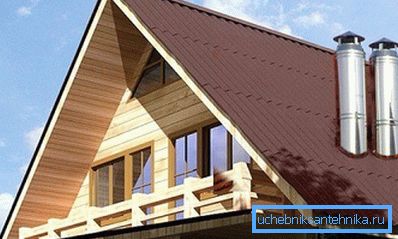
Technical characteristics of chimneys
Manufacturing material
One of the best materials for the manufacture of chimneys is galvanized steel. This is an inexpensive material that has excellent consumer properties. During operation, the chimney is subjected to strong external influences - physical and chemical. Therefore, to the details from which the exhaust systems are made, increased demands are made. They should be: ? resistant to corrosion; ? strong; ? light. As an alternative to galvanizing, some use stainless steel. But the cost of products from it is much higher than similar chimneys made of galvanized steel, and the technical characteristics are almost at the same level.
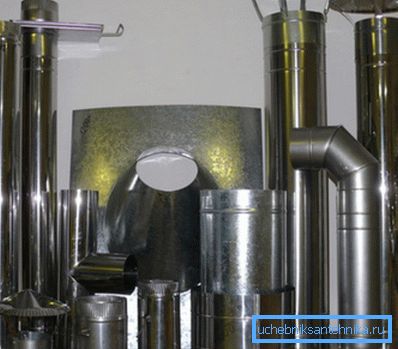
Tip! When buying galvanized pipes for the arrangement of chimneys should carefully inspect all the parts for defects. Any marriage can lead to fatal consequences for the entire chimney, up to complete inoperability.
Other options
As we have already figured out, the optimal material for the manufacture of pipes is galvanized metal. But besides this, other technical characteristics are important:? pipe height above the roof level; ? internal diameter of the chimney; ? thrust force arising in the pipe. In most cases, the higher the upper cut of the pipe is, the better the thrust. However, it is important to choose the right ratio of the internal diameter of the chimney and its height, otherwise the system may “choke” - the aerodynamics will be broken and the thrust will not be enough to completely remove the exhaust gases. Another important parameter affecting normal is the number of chimney bends. All experts agree that the smoother the pipe, the better it will work.

Remember that every knee or bend is a potential place for creating a so-called congestion that can lead to smoke in the room.
Note! The length of the horizontal sections of the chimney should not exceed 1 meter, otherwise soot will accumulate there, which can lead to complete blockage of the chimney.
Independent installation of the chimney
Preparatory stage
After acquiring a galvanized pipe of suitable diameter, it must be properly installed. But before that, it is recommended to perform a series of actions that will increase its service life and improve performance:? Before joining the components of the chimney among themselves, all seams must be treated with a special sealant. This will allow to achieve maximum tightness, since even the highest quality rolling of pipes can not provide 100% tight fit. ? It is impractical to seal the already commissioned system (for example, before extending the chimney), since the composition will not stick to the hot surface. In this case, you will need to turn off the boiler and wait for the metal to cool.
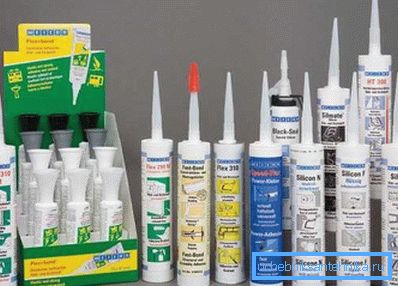
Mounting construction
As soon as the preparatory stage is completed, then we build chimney pipes according to the following scheme:? The assembly is carried out gradually. The trumpet of each subsequent link advances on the smooth part of the previous one. This prevents the formation of condensate that forms inside the pipe on the insulation used.
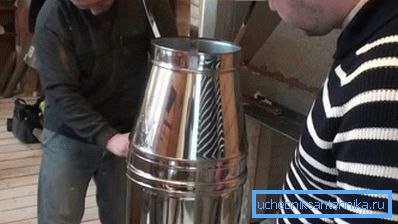
? Galvanized chimney pipe connected overlap. The length of the latter must be at least half the outer diameter of the chimney. This requires instructions for fire safety.
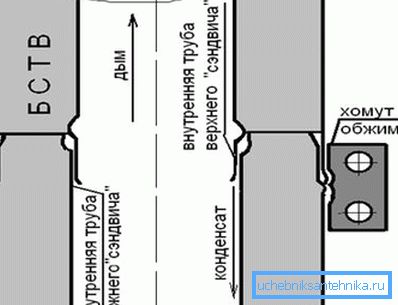
? When designing the internal chimney, it should be laid along the main walls or interior partitions. For pipe passing through interfloor overlappings special pipes are used. It is also necessary to foresee beforehand how to insulate the chimney in order to prevent a possible fire from contact of hot galvanizing with wood or other combustible materials. ? The joints of individual parts of the chimney must be further strengthened with clamps (in most cases they are included in the delivery of the pipeline). ? To ensure the rigidity of the structure, the pipe is attached to the wall with brackets. Also need to fasten all shaped parts (corners, tees, revisions, and so on).

? In the lower part of the chimney (immediately after the connecting pipe of the boiler) there is a revision opening - a door. It is useful when you think about how to clean the chimney from soot and other sediments.
Note! In no case should horizontal sections of the chimney come into contact with a gas pipeline or electrical cables. Otherwise, there may be a fire due to excessive heating of the wall of the galvanized pipe.
Warming chimney pipes
These activities should be carried out in the case when the exhaust system is mounted on the street or in non-heated premises. Answering the question why to insulate the chimney, it should be noted that this is necessary to ensure the channel is heated as quickly as possible and to prevent the formation of condensate inside it. In addition to its main purpose, insulation plays the role of an insulator and is used when the chimney is located in close proximity to flammable or combustible materials. This helps prevent a possible fire.
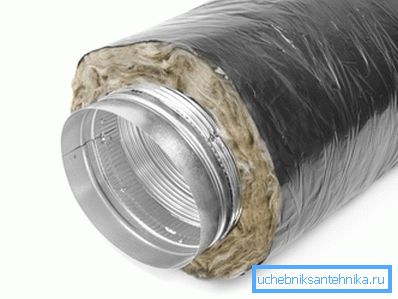
Tip! In the construction supermarkets for sale chimney pipe with thermal insulation. It is a multi-layer construction, one of the layers of which has a low coefficient of thermal conductivity. The chimney made of such a pipe does not require additional insulation. The disadvantage is the higher price.
Another important point is the protection of the upper cut of the pipe from precipitation and ingress of garbage. To do this, use: grids; ? weathervanes; ? deflectors of various designs.
Chimney service
In addition to the correct installation of pipes, they must be properly operated. It is very important to know how to clean the chimney from the sediments formed there. There are three main ways: Mechanical. In this case, use a special tool - brush or a metal brush. With a strong blockage can be used heavy metal weight, mounted on a chain. Ruff for cleaning chimneys has long been known and is still considered one of the most effective devices. It allows you to precisely adjust the force and control movement along the chimney. If thick deposits have formed on the pipe, before cleaning the chimney pipe, one should put the weight down and, swinging it from side to side, knock on the walls of the chimney, which will cause the collapse of soot layers, which should then be removed through the hole in the chimney base.

Tip! Before cleaning, all valves should be pushed in, otherwise a cloud of soot could get into the boiler room or another room where the boiler is installed.
? Chemical. To do this, apply special chemicals produced in solid or liquid form. They must be added to the fuel used and burned in the firebox. Liquid formulations are used to impregnate the walls inside the chimney, which in itself prevents soot deposits. ? People's. Can only be used for cleaning chimneys, made of heat-resistant bricks. To get rid of soot in the furnace, a high temperature flame is ignited and maintained, which leads to the complete burning of soot. In this case, the fuel can be potato peelings, aspen firewood or special log - “chimney sweep”. This is the easiest way to remove soot with your own hands.
Conclusion
Properly assembled and operated chimney pipes are a guarantee of the normal operation of the heating system and the safety of people. After all, the carbon monoxide accumulated in the room can lead to poisoning, and in some cases - the death of the inhabitants of the house.
More details about the construction of pipelines can be found in the video in this article.